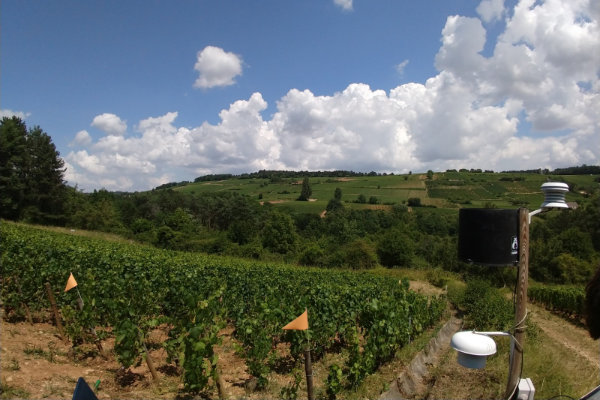Sébastien Zito PhD thesis
 Climate change impacts on phytosanitary risk evolution in north-eastern France vineyards: observations and modeling
Climate change impacts on phytosanitary risk evolution in north-eastern France vineyards: observations and modeling
Started in november 2016
Funding: BIVB (Bureau Interprofessionnel des Vins de Bourgogne) and CIVC (Comité Interprofessionnel des Vins de Champagne)
Supervisors: Yves Richard and Benjamin Bois
Defended the 8 july 2021
Abstract
From now on, agriculture must adapt and anticipate climate change, whose impact has already been observed on the biology of crops and their production. Beyond plants, this climate change also impacts pathogen development and therefore host/pathogen interactions. Thus, building adaptation strategies requires considering not only the crops but also the organisms with which they interact. The objective of this thesis is to characterize the impact of climate change on the phytosanitary risk related to grapevine powdery mildew (Erysiphe necator) in the wine regions of Burgundy and Champagne. More particularly, it questions two central aspects related to the epidemic risk: the grapevine sensitive period to disease and the impacts of climatic conditions on pathogen development. For the current period, after comparison with field observations, different models are used to simulate grapevine phenology and powdery mildew development. For the 21st century, climate projections from General Circulation Models (GCMs) at coarse resolution (100-150 km) are simultaneously statistically downscaled and bias-corrected in order to produce data at 8 km resolution, consistent with observation over the historical period (1961-2005). These data are used to feed models simulating the evolution of the phenological stages of the plant sensitive period and the development conditions of the pathogen. The developed method is tested on the historical period and then projected on the whole XXIst century. It allows to apprehend uncertainties related to climate modeling (22 GCMs), to forcing pathways (RCP4.5 and 8.5), to phenological modeling (3 models) as well as to the simulation of meteorological parameters influencing the intensity of powdery mildew (temperatures, precipitations, relative humidity). Within the vineyards of Champagne and Burgundy, several factors, including the advancement and shortening of the sensitive period associated with a change in climatic conditions during these periods, are determined to play a role in powdery mildew pressure and its potential evolution during the 21st century. The results of this study will contribute to a better understanding and anticipation of the risks related to this pathogen while considering strategies for adaptation to climate change.
Keywords
climatic change, wine growing, grapewine diseaeses, modelisation
Jury
Marie Launay, INRAe, reviewer
Hervé Quenol, CNRS, reviewer
Nathalie Ollat, INRAe, examiner
Marielle Adrian, université Bourgogne Franche-Comté, examiner
Yves Richard, université Bourgogne Franche-Comté, supervisor
Benjamin Bois, université Bourgogne Franche-Comté, cosupervisor
Agnès Calonnec, INRAe, invited
- extrait:
- lien_externe:
- kc_data:
- a:8:{i:0;s:0:"";s:4:"mode";s:0:"";s:3:"css";s:0:"";s:9:"max_width";s:0:"";s:7:"classes";s:0:"";s:9:"thumbnail";s:0:"";s:9:"collapsed";s:0:"";s:9:"optimized";s:0:"";}
- kc_raw_content:
 Climate change impacts on phytosanitary risk evolution in north-eastern France vineyards: observations and modeling
Climate change impacts on phytosanitary risk evolution in north-eastern France vineyards: observations and modelingStarted in november 2016
Funding: BIVB (Bureau Interprofessionnel des Vins de Bourgogne) and CIVC (Comité Interprofessionnel des Vins de Champagne)
Supervisors: Yves Richard and Benjamin Bois
Defended the 8 july 2021
Abstract
From now on, agriculture must adapt and anticipate climate change, whose impact has already been observed on the biology of crops and their production. Beyond plants, this climate change also impacts pathogen development and therefore host/pathogen interactions. Thus, building adaptation strategies requires considering not only the crops but also the organisms with which they interact. The objective of this thesis is to characterize the impact of climate change on the phytosanitary risk related to grapevine powdery mildew (Erysiphe necator) in the wine regions of Burgundy and Champagne. More particularly, it questions two central aspects related to the epidemic risk: the grapevine sensitive period to disease and the impacts of climatic conditions on pathogen development. For the current period, after comparison with field observations, different models are used to simulate grapevine phenology and powdery mildew development. For the 21st century, climate projections from General Circulation Models (GCMs) at coarse resolution (100-150 km) are simultaneously statistically downscaled and bias-corrected in order to produce data at 8 km resolution, consistent with observation over the historical period (1961-2005). These data are used to feed models simulating the evolution of the phenological stages of the plant sensitive period and the development conditions of the pathogen. The developed method is tested on the historical period and then projected on the whole XXIst century. It allows to apprehend uncertainties related to climate modeling (22 GCMs), to forcing pathways (RCP4.5 and 8.5), to phenological modeling (3 models) as well as to the simulation of meteorological parameters influencing the intensity of powdery mildew (temperatures, precipitations, relative humidity). Within the vineyards of Champagne and Burgundy, several factors, including the advancement and shortening of the sensitive period associated with a change in climatic conditions during these periods, are determined to play a role in powdery mildew pressure and its potential evolution during the 21st century. The results of this study will contribute to a better understanding and anticipation of the risks related to this pathogen while considering strategies for adaptation to climate change.
Keywords
climatic change, wine growing, grapewine diseaeses, modelisation
Jury
Marie Launay, INRAe, reviewer
Hervé Quenol, CNRS, reviewer
Nathalie Ollat, INRAe, examiner
Marielle Adrian, université Bourgogne Franche-Comté, examiner
Yves Richard, université Bourgogne Franche-Comté, supervisor
Benjamin Bois, université Bourgogne Franche-Comté, cosupervisor
Agnès Calonnec, INRAe, invited
